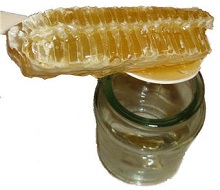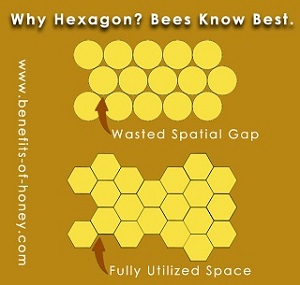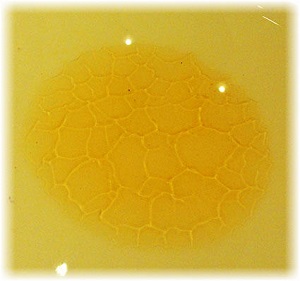
Hexagonal Honeycomb Pattern
Why is the shape of a honeycomb cell hexagonal, and not square, round, triangle, rectangle, rhombus, or even pentagon? Has any kid asked you this question before? If you can't get away by telling them because the bees are insects and insects have six legs, and thus they make six-sided homes, read this as it might help somewhat, or perhaps even leave you and all the adults and kids agog.
The answer in a nutshell - hexagon is the most efficient shape for the bees' living and storing of food.

The bees already have enough awesome abilities to wow us - their pollination of over 90 fruit and vegetable crops worldwide, their phenomenal sense of smell, their incredibly speedy wings that make their famous, distinctive buzz, their highly organized society and intricate cooperation, and their communication with one another by "dancing".
Turning to the structural design of their homes, it also suggests that they excel in economics and mathematics! Studies on the geometry of honeycomb pattern explain that no other shape can create more space with the given material. Circles for instance leave space, and square makes smaller area. In addition, your engineer friends can confirm with you that the hexagon structure provides the maximum strength and that it is used in designing airplane wings and satellites walls.

Though the wax cell walls may be only about 0.05mm thick, each cell can support 25 times its own weight. The bees have chosen the hexagon as a building cell for their combs to achieve the maximum strength to store their food - honey in it: a comb of 100 g weight can hold in it up to 4 kg of honey! Producing wax is a laborious process. For each gram of wax produced, the bee needs to consume 6 to 7 grams of honey. The bees are genetically able to calculate, design, and construct a structure that provides the most living and storage space for their larvae, honey and pollen utilising the least resources and energy!
Wow, these insects are born engineers and economists! And modern design today has borrowed the bee's building principle for achieving spaciousness, strength, and sturdiness in creation of countless indoor structures, furniture, and household and office products.
Yet another spectacular work of the honeybees and the creator of this universe!
It takes a bee to get the honey out.
~ Arthur Guiterman
Hexagonal Honeycomb Pattern in Purity Test
Many have claimed the amazing formation of hexagonal patterns on a film of honey as a proof of purity. Too curious to dismiss it, I followed the instructions given:
1. Put a blob of honey onto a light coloured round plate.2. Pour in some cold water to cover the honey.
3. Swirl the plate several times.
4. If the honey is pure, you would see a honeycomb image/pattern on the honey.
And the outcome? Right before my very eyes, with a couple of swirls, I saw a honeycomb pattern consisting of big hexagonal shapes form on the surface of the honey patch, and with several more swirls, the hexagonal cells split into smaller ones, and here's a snapshot of what was observed:

My verdict?. I'm still not sure how this points to honey purity. I've also tried the same test with adulterated honey (half very concentrated syrup and half honey mixed) and there no pattern was observed. But that was only one type of syrup, and I suppose amount of syrup versus honey also matters, there are too many variables involved in such a purity test. Also, evidence on the presence of pure honey does not automatically rule out the presence of other substances or ingredients such as starch, maltose, corn syrup, etc. So, is this test a test of 100% pure honey or just the presence of pure honey? Could this comb pattern be related to any concentrated form of sugar syrup (and not just honey) since we know similar pattern can occur with rock sugar and candy bars? (See Honeycomb Sweets below.)
Whatever the answers may be, the observation described above is enough to wow me. Incredible, beautiful phenomenon!
Related Pages
1. Sweets with a "Honeycomb" label or manufactured to appear like real honeycombs seem to be able to present themeselves as healthier options. See in here some of these sweets that many of us have got ourselves hooked on: World of Honeycombs.
2. If you are located in Singapore, check out the honeycombs at: Bee Healthy
3. Has any kid asked you before why the shape of a beehive honeycomb pattern is hexagonal? Read: Hexagonal Honeycomb Pattern.
End of "Hexagonal Honeycomb Pattern" Back to "Honey Bees and Their Wondrous Products"